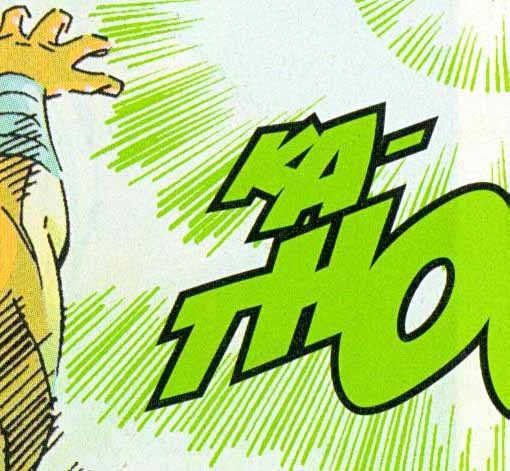And Then I Read: LEGION OF SUPER-HEROES ANNUAL 1
Images © DC Comics, Inc.
I don't usually read annuals these days, but decided to try this one, as it's the first time writer Paul Levitz and artist Keith Giffen have teamed up on a Legion story in quite a while. The focus (no pun intended) is on a new version of the Emerald Empress and her powerful huge green eyeball. The planet Orando, home world of Sensor Girl, is where the emerald power lies, and a woman running from a man she hates, who wants her for his bed, stumbles into it, and is transformed into a powerful new being, as seen above. Knowing nothing of this, Lightning Lass and Shrinking Violet have chosen Orando for what they thought would be a fun vacation. Not so much. The Empress is not only powerful, she's unbalanced mentally, and what she's doing to Orando is not good for anyone living there except her. The Legionnaires try to defy her, but don't get far until more Legion help arrives. A good deal of fighting and explosions occur throughout, but Paul keeps the story rolling along well, too. And there are two fun backup features, a Legion History board game, and an illustrated Interlac alphabet primer.
I imagine Keith Giffen was involved in the plotting of this story, as well as pencilling it. He's going for his Jack Kirby style throughout, in fact maybe a bit too much so: all the women in the story look rather like Big Barda. One thing that really stood out for me was the coloring, especially the vibrant greens that surround the Empress and her powers. Looking closely I realized a spot color had been used throughout the book, something I've never seen done on the inside pages of a comic. On covers occasionally, yes, but never on inside pages. It's an added expense, but in this case I think the results were well worth it, the colors really are stunning all through the story. Colorist credit is "Hi-Fi," don't know who that is exactly, but they've made great use of the spot color as well as the regular ones.
Here's a close look at some of that green, filling the sound effect and used as a color hold on the burst lines. That's all 100% green spot color, not the usual combination of yellow and blue inks, with the blue broken up into small dots to get a bright green. Comics color has come a long way since I was involved in it in the 1980s, and now it's stepping up into even finer levels with tricks like this.
Great looking issue, fun to read, recommended!
Todd Klein's Blog
- Todd Klein's profile
- 28 followers






